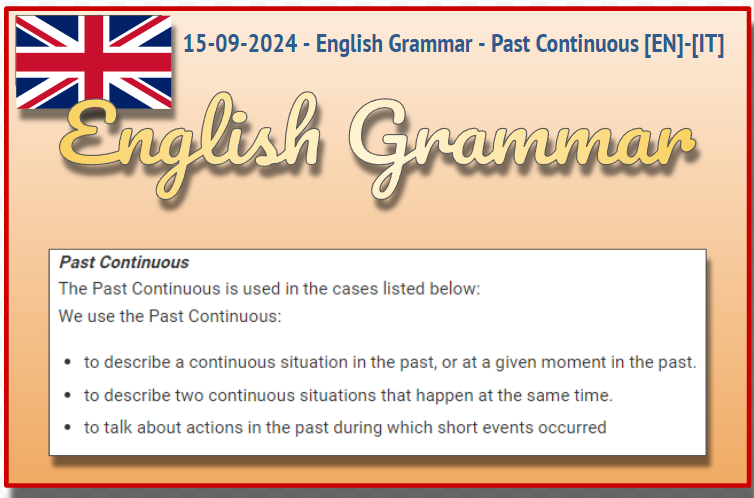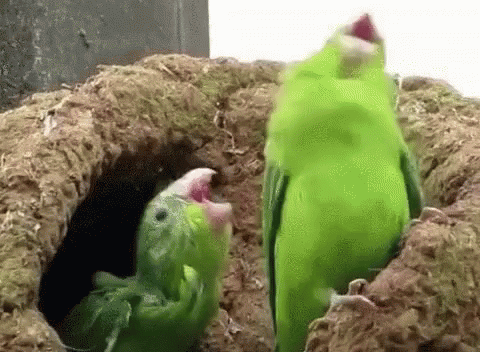15-09-2024 - English Grammar - Past Continuous [EN]-[IT]

~~~ La versione in italiano inizia subito dopo la versione in inglese ~~~
ENGLISH
15-09-2024 - English Grammar - Past Continuous [EN]-[IT]
With this post I would like to give a short instruction about the topic mentioned in the subject
(code notes: X87)
Past Continuous
The Past Continuous is used in the cases listed below:
We use the Past Continuous:
to describe a continuous situation in the past, or at a given moment in the past.
to describe two continuous situations that happen at the same time.
to talk about actions in the past during which short events occurred
How to construct it
It is constructed with the subject + was/were + verb in -ing
Here is the construction of the affirmative, negative and interrogative forms:
Affirmative Form
Subject + was/were + verb in -ing
Negative Form
Subject + was/were + not + verb in -ing
Interrogative Form
Was/were + subject + verb in -ing
Example:
Let's imagine we want to inform a colleague of ours that last Monday we gave a presentation at 3.
In this case we are describing a situation at a given time in the past.
So we will have to use the Past Continuous as the form of the green.
The sentence therefore, with the Past Continuous form in bold, will be the following:
I was just giving a presentation at 3 last Monday.
Example 02:
Now suppose we want to let someone know that while we were busy doing our homework, our friend George was playing football. In this situation we are in the case where we are describing two continuous situations that occur at the same time. We must use the Past Continuous.
The correctly written sentence is as follows (the Past Continuous form is in bold)
While we were writing our homework, George was playing football.
Example 03:
Now let's see another sentence that we must construct with the Past Continuous.
Imagine we want to let someone know that the last time our friend Lara had met a friend of ours, our friend was looking for a job.
The sentence is written correctly in the following form (the Past Continuous verbs are in bold)
When Penny last saw him, he was looking for a job.
Conclusions
The Past Continuous is used when we describe an action in progress at a specific moment in the past, when we talk about parallel actions in progress in the past, when we refer to an action interrupted by another action in the past and to describe the atmosphere of a situation
Question
Sometimes I have trouble understanding precisely when the Past Continuous is needed. Do you find it easy to use the Past Continuous?

[ITALIAN]
15-09-2024 - Grammatica inglese - Past Continuous[EN]-[IT]
Con questo post vorrei dare una breve istruzione a riguardo dell’argomento citato in oggetto
(code notes: X87)
Past Continuous
Il Past Continuous viene usato nei casi elencati qui sotto:
Usiamo il Past Continuous:
per descrivere una situazione continua nel passato, o in un dato momento nel passato.
per descrivere due situazioni continuative che accadono contemporaneamente.
per parlare di azioni nel passato durante le quali si sono verificati eventi brevi
Come si costruisce
Si costruisce con il soggetto + was/were + verbo in -ing
Qui di seguito la costruzione delle forme affermative, negative ed interrogative:
Forma affermativa
Soggetto + was/were + verbo in -ing
Forma Negativa
Soggetto + was/were + not + verbo in -ing
Forma Interrogativa
Was/were + soggetto + verbo in -ing
Esempio:
Immaginiamo di volere informare un nostro collaboratore di lavoro che lunedì passato abbiamo fatto una presentazione alle 3.
In questo caso stiamo descrivendo una situazione in un dato momento nel passato.
Quindi dovremo usare come forma del verdo il Past Continuous.
La frase quindi, con la forma del Past Continuous in grassetto, sarà la seguente:
I was just giving a presentation at 3 last Monday.
Esempio 02:
Supponiamo ora di volere far sapere a qualcuno che mentre noi eravamo impegnati a svolgere i compiti, il nostro amico George giocava a calcio. In questa situazione siamo nel caso in cui descriviamo due situazioni continue che si verificano contemporaneamente. Dobbiamo usare il Past Continuous.
La frase scritta correttamente risulta come segue (in grassetto la forma del Past Continuous)
While we were writing our homework, George was playing football.
Esempio 03:
Ora vediamo un altra frase che dobbiamo costruire con il Past Continuous.
Immaginiamo di voler far sapere che l'ultima volta che la nostra amica Lara aveva incontrato un nostro amico, il nostro amico stava cercando lavoro.
La frase è scritta in maniera corretta nella seguente forma (in grassetto i verbi del Past Continuous)
When Penny last saw him, he was looking for a job.
Conclusioni
Il Past Continuous si usa quando descriviamo un'azione in corso in un momento specifico nel passato, quando parliamo di azioni parallele in corso nel passato, quando riferiamo di un'azione interrotta da un'altra azione nel passato e per descrivere l'atmosfera di una situazione
Domanda
Io a volte faccio fatica a comprendere precisamente quando serve il Past Continuous. A voi risulta facile l'uso del Past Continuous?
THE END
Past continuous is quite difficult for me so I mostly ignore it but thanks so much for this
Most times I forget this when communicating. It's a good thing that you remind us
Thank you for this reminder
English language may be hard at times😅
Thank you for this comprehensive teaching. I really learnt a lot
https://x.com/lee19389/status/1835830042762322006
#hive #posh
Non lo trovo particolarmente difficile. Le difficoltà maggiori con l'uso dei tempi verbali riguardano la mancanza di corrispondenza tra la lingua di partenza e la lingua alvo (del tipo dove nella lingua di partenza è obbligatorio il condizionale e nella lingua alvo il congiuntivo oppure nella lingua di partenza è obbligatorio il congiuntivo e nella lingua alvo l'indicativo oppure ancora la lingua alvo prevede tempi verbali inesistenti nella lingua di partenza). Tali cose amene accadono quando si studiano spagnolo e portoghese, che prevedono il futuro congiuntivo (inesistente in italiano). Entrambe le lingue sono un vero spasso a livelli avanzati. In portoghese coniugano pure l'infinitivo, facilissimo da confondere con il presente congiuntivo e in spagnolo, a seconda del contesto, usano il presente dell'indicativo ove in italiano è obbligatorio il congiuntivo in presenza dello stesso avverbio che impone appunto il congiuntivo in italiano. E il bello è che durante gli esami per ottenere certificati internazionali sono considerati errori gravi e gravissimi a livelli un minimo elevati:

!LOLZ
lolztoken.com
He was charged with battery
Credit: reddit
@stefano.massari, I sent you an $LOLZ on behalf of pousinha
(1/2)
Grazie per questo commento. Con quello che hai descritto ho compreso che ci sono delle difficoltà ancora maggiori con altre lingue per quanto riguarda l’uso dei verbi
E le difficoltà sono accentuate a causa dei metodi moderni d'insegnamento delle lingue straniere che trascurano troppo la grammatica in favore della fluenza nella conversazione il più rapidamente possibile (l'inverso di quanto avviene nelle università, dove il metodo grammaticale prevale a scapito del linguistico). Ecco il motivo principale per il quale ai professori di lingue straniere che escono dalle università spesso manca la padronanza linguistica, mentre chi esce da un corso moderno standard riesce facilmente a superare un esame internazionale di livello A e B, ma arrivati al C casca l'asino perchè oltre alla padronanza nella conversazione, ti fanno le pulci sulla grammatica (ma per forza di cose).
Sulle lingue sai davvero tante cose! Anzi mi sto chiedendo cos’è che non sai?!
Le funzioni polinomiali, che quelle davvero non le so risolvere🤣:
